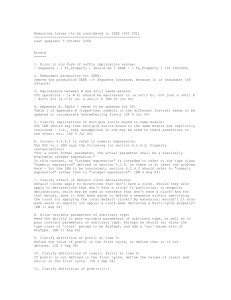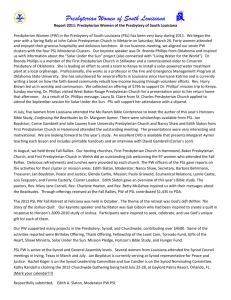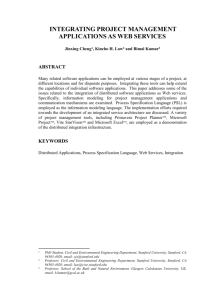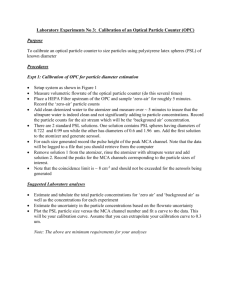Installation of PSL and REDUCE for UNIX systems based on
advertisement
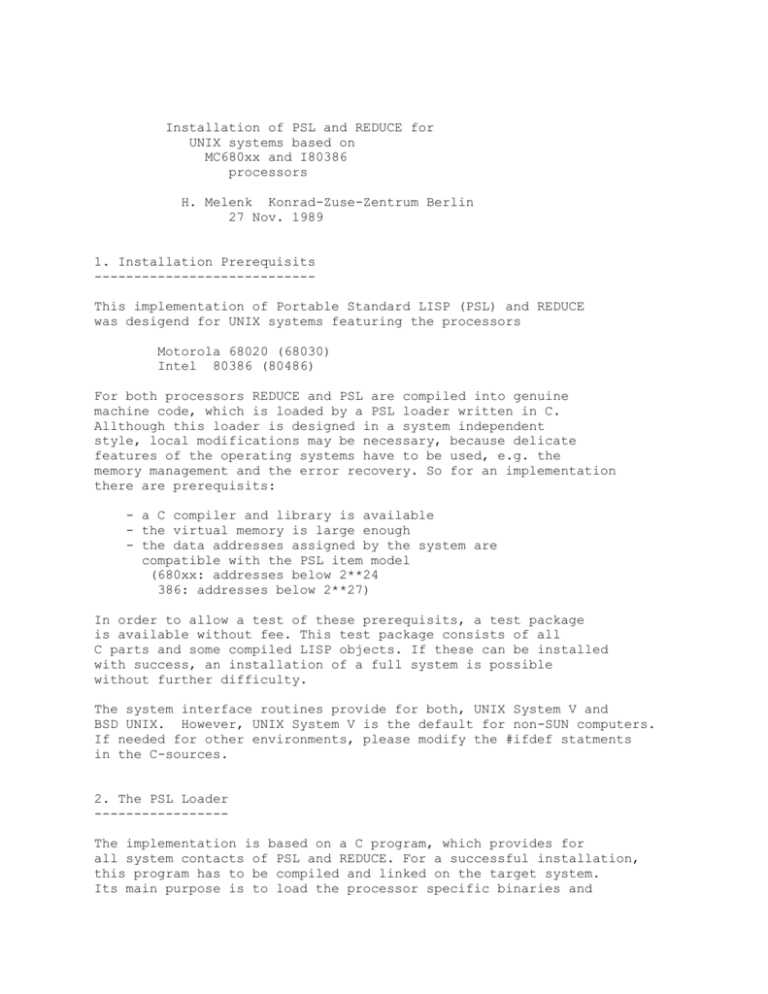
Installation of PSL and REDUCE for UNIX systems based on MC680xx and I80386 processors H. Melenk Konrad-Zuse-Zentrum Berlin 27 Nov. 1989 1. Installation Prerequisits ---------------------------This implementation of Portable Standard LISP (PSL) and REDUCE was desigend for UNIX systems featuring the processors Motorola 68020 (68030) Intel 80386 (80486) For both processors REDUCE and PSL are compiled into genuine machine code, which is loaded by a PSL loader written in C. Allthough this loader is designed in a system independent style, local modifications may be necessary, because delicate features of the operating systems have to be used, e.g. the memory management and the error recovery. So for an implementation there are prerequisits: - a C compiler and library is available - the virtual memory is large enough - the data addresses assigned by the system are compatible with the PSL item model (680xx: addresses below 2**24 386: addresses below 2**27) In order to allow a test of these prerequisits, a test package is available without fee. This test package consists of all C parts and some compiled LISP objects. If these can be installed with success, an installation of a full system is possible without further difficulty. The system interface routines provide for both, UNIX System V and BSD UNIX. However, UNIX System V is the default for non-SUN computers. If needed for other environments, please modify the #ifdef statments in the C-sources. 2. The PSL Loader ----------------The implementation is based on a C program, which provides for all system contacts of PSL and REDUCE. For a successful installation, this program has to be compiled and linked on the target system. Its main purpose is to load the processor specific binaries and to organize their linkage to the system. The C program is compiled from the following set of source files: psll.c echo.c file-status.c float.c misc.c pslextras.c sigs.c unix-io.c main program terminal control file control floating point arithmetic embedding for some c library routines control o signal handling input-output routines As an additional file for the C compilation psll.h is needed, which is generated by the PSL compiler at kernel compile time; this file defines the interface between LISP and C and is specific for the individual kernel. The compatibility of this header and the kernel to be loaded is controlled by a magic number. However, if that file is modified by hand in an unappropriate manner, the compatibility gets lost without control. Once compiled and linked, the main programm psll is available. Its operation is controlled by the following parameters: psll [option...] The psll command invokes the PSL loader and accepts the following types of arguments: - arguemnts beginning with -i , -b, -h, -s, -v these are interpreted by psll directly - other arguments, which will be passed to the object to be loaded. OPTIONS -ixxx xxx should be a legal file name. It is interpreted as the binary to be loaded by psll. So it mus be a file which contains either a kernel (e.g. main.b) or a saved system image (e.g. psl.img), which is compatible with the version of psll. -vn n 0 1 2 should be 0, 1 or 2; 0 is the default. : no load map : print map of memory allocation : print full relocation tables -dqqq qqq should be a directory (or expand to a directory). If set, a "cd" to this directory will take place AFTER loading but BEFORE starting the image. This is used during system generation (qqq as directory of the non-kernel modules). the following options are interpreted only when a kernel is loaded; they overwrite the memory size values which the kernel inherited from his parent; the paraemters are decimal numbers; -bnnn nnn new size of binary program space in bytes -hmmm mmm new size of heap space in bytes; note that here the total space for both heaps has to be given; so a "-h8000000" corresponds to a system with two heaps of 1000000 LISP items (each with 4 bytes). -skkk kkk new size of the stack in bytes; each stack item needs four bytes. This value has effect only for implementations where PSL does not use the UNIX system stack. It has no effect otherwise, e.g. for I80386 processors. The loader psll tries to check as much as possible and to give readable comments in case of problems. At least during memory initialization all problems should be detected. If an error analysis for the execution of the started object is necessary, the entry point "execute" in psll is an appropriate breakpoint e.g. for adb or dbx; here the execution of the loaded program starts. There are two modes of operation: - kernel loading - image loading. If the system is started from scratch, PSLL loads the PSL kernel, which is a binary generated by the PSL compiler in a specific mode. This kernel is a minimal environment with a memory manager, a LISP specific loader, some untility functions and the interface to the operating system in mapped to the LISP function protocol. The kernel then loads a set of up to 80 LISP binaries, the "nonkerenl", which then establish a complete LISP environment, the so called "bare-psl". This complete environment can be used for LISP execution (e.g. for loading additional modules). Especially is it enabled, to conserve itself for later reexecution. This operation is called "savesystem" and generates an image file, which contains the complete environment in the current state. Once an image has been generated, it can be loaded and started by PSLL direcly later on. E.g. the REDUCE program usually is generated as an image in that style, but other PSL application environments can be supported in the same style. 3. The Test Package ------------------Usually the test package is written in tar format to a 3.5 minidisc. In a full PSL or REDUCE UNIX installation tape, the test package should be a subdirectory "tests" in the directory "$pxk"; its source files then should be link entries to the corresponding sources in $pxk. 3.1 Test 1 and test 2 ---------------------These are minimal tests. There is a shell script test-1-2.cs which performs all actions necessary. When started, the first time, please ensure that all compilations and the linkage are performed without problems. If there are problems, it might be necessary to perform the steps of this script one after the other by hand. Test 1: The kernel is able to print some fixed messages to the terminal. The binary file is "testkern.b" and the corresponding header file is "psll.ht1". If operating properly, it will print Hello World: 32 good luck when installing However, the memory requirements of a full PSL are activated with this test already. In test 2 test the actual PSL kernel "main.b" is loaded and the it then tries to load another module "load-psl.b", which tests some of the kernel routines. On this level only a minimal environment is available, but the system interface is fully present. The dynamic operation of this test can be understood by looking to the source file for this test "make-t2". Please inform us about any modfications which are necessary to get the packages run. We would like to incorporate them into the general distribution versions. 3.2 Test 3 ---------This test generates the bare PSL interpreter, which enables a (limited) LISP program execution. For that test, PSLL has to load the nonkernel modules, which reside in the subdirectory "nonkern". Please stay in the tests directory all the time. If the machine has no ARITHMETIC CORPOCESSOR, please move the module nonkern/arithwoco.b (arithmetic without coprocessor) to nonkern/arithmetic.b The script "psl" invokes the PSL interpreter. During loading one message line from each of the 78 modules is generated. If the loading is successfull, the lines Portable Standard LISP 1 lisp> appear on the terminal and the LISP interpreter waits for interactive input. Note that the current directory now points to "nonkern". You can enter expressions in PSL syntax, e.g. you can execute the file "source3.sl" by typing in (rds (open "../source3.sl" 'input)) The .. is needed here, because the directory was changed to ./nonkern during loading. The main purpose of this file is the testing of the error recovery. So several error messages will occur. Please reply q every time, which then will cause continuation of the file. As one effect of this file an executable PSL interpreter image is saved to the file "sav.img". This image should be executable later by calling psll -isav.img A LISP session will be ended executing of (quit) or with a ctl-D character. The sript "psl" does this operation as well. Please check, if the heap enlargement operates by starting psl from the saved image and the executing (set-heap-size nnnnnn) where "nnnnn" is a number greater than the current heap size, e.g. 1000000. Then two garbage collections take place. If the enlargement is successfull, the new size is returned; otherwise the value will be NIL. If not successfull, several reasons can be responsible. If PSLL reports a problem in the SBRK management, please try to adjust the sizes of the gaps incorporated in the psll.c source and redo the installation steps. The script "make-psl.cs" does all steps of compiling, linking and image creating directly without invoking the tests. 3.3 Test 4 ---------This test creates a minimal REDUCE on top of PSL. Therefore change the current directory to cd rtest and execute the script make-reduce.cs which then produces a file "reduce.img". If this image is executed via ../psll -ireduce.img or by the script reduce the mini REDUCE is started and expects interactive input. As usually with REDUCE, all statements have to be separated by a semicolon and terminated by a return-key. In contrast to the full REDUCE here only two types of statements are accepted: bye; terminates the program <expr>; evaluates the (polynomial) expression <expr> where <expr> is limited to a (legal) combination of balanced brackets, operators +,-,* and **, small integer numbers and simple variables. E.g. type in (x + y) ** 10; If all these tests were successfull, it is very probable that the full REDUCE can be installed without further problems. Please inform us about any modfications which are necessary to get the packages run. We would like to incorporate them into the general distribution versions. 4. Installing "bare-psl" and other LISP environments ---------------------------------------------------When the tests are completed successfully, the final installation can be started. Prerequisits: - the file tree has been installed - the variable MACHINE has been set to unix386 resp. unix68000 - the file /psl/dist/psl-names has been executed So all necessary files and file names are defined and accessible. Switch to the machine dependent kernel directory cd $pxk Remove all .o files; the .o files on the distributtion tape were compiled under SUN-OS and so will not be compatible with the target system. rm .o Replace those .c files, which were modified during preparation of the test series. Ensure, that the following binary files have a younger date than their corresponding sources, e.g. by executing a touch command: binary: kernelout.b main.b $pl/fasl-decls.b $pl/f-strings.b $pl/fast-vector.b $pl/hash-decls.b $pl/if-system.b $pl/s-strings.b $pl/sys-consts.b source: kernelout.sl all .sl files in $pk and $pxk $pxk/fasl-decls.sl $pu/f-strings.sl $pu/fast-vector.sl $pk/hash-decls.sl $pu/if-system.sl $pu/s-strings.sl $pxc/sys-consts.sl If the machine has no arithmetic coprocessor, move the file $pxnk/lap/arithwoco.b to $pxnk/lap/arithmetic.b Generate the PSL loader by executing the command make Switch to the machine dependent distribution directory cd $pxdist The script make-bare-pslin this directory generates an executable LISP environment by calling psll, loading the modules in $pnkl and writing a SAVESYSTEM image for later restart. The memory layout of the executable image is defined in this script as parameters to psll. When modirying the parameters, take into account, that the heap space should be enlargable at runtime. For generating the bare psl execute make-bare-psl Afterwards the bare PSL can be executed via $psys/bare-psl The other files make-psl and make-pslcomp generate a full psl and a psl compiler in the same way. Other LISP environments can be installed in the same style. The standard PSL is created by make-psl while make-pslcomp generates the PSL compiler main program.



